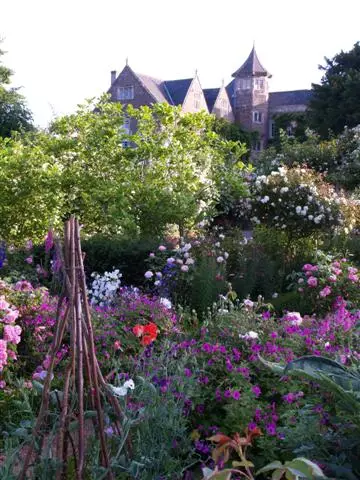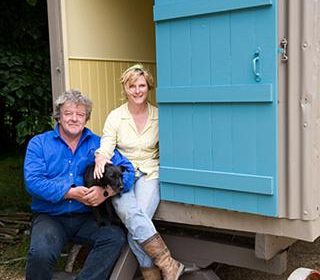HANHAM COURT GARDENS
Hanham Court
Hanham Abbots
Bristol
BS15 3NT
Unexpectedly rural Manor house half way between the centres of Bath and Bristol, a Monastic foundation with 13th century Church and Tithe barn and ponds at the end of a tiny lane among fields. Julian and Isabel Bannerman, award winning garden designers to the Prince of Wales, have created over fifteen years a deeply romantic, highly scented garden, part formal with luscious borders of old roses, tree peonies, lilies, and fountains – including the amazing ‘Dancing Crown’ – plus woodland with stream, cascades, pools, temples, tree ferns, magnolias, snowdrops plus parkland, orchards, wild flowers, vegetable/cutting garden
Hanham Court – Romans Normans and Bannermans
Julian and Isabel Bannerman have worked together designing and making gardens and buildings since 1983. As well as trees, shrubs and herbaceous plants their gardens contain swimming pools, lakes, fountains, rills, cascades, follies, ruins, summer houses, romantic ruins, temples and rustic artifices and sculpture. They recently won a competition to design the British Memorial Garden to 9/11 in New York with a contemporary garden design and are past winners of an RHS Chelsea Flower Show Gold Medal, and also a Civic Trust Award and a Europa Nostra Award for buildings they have designed.
Location: Old Bristol Rd A431 from Bath, through Wilsbridge, L down Court Farm Rd for 1m, L down Ferry Rd at St Stephens Green, before Chequers PH
www.hanhamcourt.co.uk
On the Via Julia from Bath ( Julian Road ) to the Roman Port at Avonmouth the House stands above the river Avon at a strategic point and ancient Ferry Crossing. Most of the tithe Barn we see today is Norman, built in the 11th century, the Church which is connected to the House is 15th Century dating from the point when the House was part of Keynsham Abbey – on the Somerset side of the River, the site of which is now part of Fry’s chocolate factory. Soon after the dissolution of the monasteries it became the country estate of the Creswicke family, who were Mayors of Bristol, for nearly four hundred years. Historically and Architecturally there is something from almost every century since the conquest; the Tudor Gables and Gatehouse; the knighting of the Creswickes by Charles I who remained loyal through the Civil War, but were wrongly imprisoned in following Monmouth’s rebellion on evidence from their neighbours and bitter rivals the Longs of nearby Barr’s Court ( now demolished ). When their innocence was proved by the testimony of the rebels themselves James II came down to pardon the Creswickes and a deer was eaten in celebration under the Oak tree by the church. When this veteran tree fell over in September 1997 we planted an acorn from the in exactly the same spot. Georgian improvements were possibly suggested by John Wood who was church warden with the Creswickes for the seven years that he lived at Bitton the chapel of ease here being part of the parish of Bitton. In the 19th century came the ‘re-gothification’ when Mr White from London spent his money adding reclaimed mediaeval gargoyles and the pointed roof to the existing Tudor corner tower. The garden still shows the influence of the celbrated 18th century plantsman and garden writer Canon Ellacombe of Bitton, who wrote a hugely popular book ‘In A Gloucerstershire Garden’, as he mentions happy times at Hanham Court and thousands of cyclamen and snowdrops surviving in the garden suggest his hand. About 1900 an Arts and Crafts Kitchen wing extending the house to the west and providing Loggia. In 1993 Julian and Isabel Bannerman moved in with their three sons and began the huge job of restoring the house and garden.
Tanya Compton in House and Garden….
“This fusion of the talents of two spirited individuals informs their unusual style…joyously creative, intellectually informed but funky.”
“The most eclectic couple in modern garden design.”
Mary Keen – The Telegraph….
” They do romantic swoony gardens better than anyone and their displays of delphinium and roses are staggering, as is the architecture of their follies and stumpery and other fantastical events.”
Emma Bridgewater in the Yellow Book
“Old roses and pots of giant agapanthus crowd around the walls and the whole effect is so compelling and entrancing that it is hard to drag oneself away…lots of loving and stylish and inspiring gardening…. the king of surprising private gardens.”
Penelope Hobhouse writes…
‘Your garden is truly wonderful…you should open it…..’
Stephen Lacey The Telegraph Magazine
“unashamedly romantic, oozing scents…but the real signature is architectural flights of fancy..”
“despite being right down the eastern end of Bristol’s suburbs…pass through the entrance gate tower and you are in another world… of art, history , children , dogs, meals alfresco….the landscape a joy, with limestone downland full of wild flowers….a wooded dell below their bastion garden flaunting stands of giant white Himalayan lilies and a small forest of tree ferns…”
Hannah Rothschild World of Interiors Magazine
” Julian and Isabel Bannerman were chosen to redesign the Dairy building …and also the Water Gardens at Waddesdon…because their work showed consistent flair and brilliant use of traditional materials.”
Celina Fox Centurion Magazine
” Julian and Isabel – purveyours of garden magic – have flashes of inspiration and twists of imagination that make you gasp with surprise for being so brilliantly apropos.”
Mary Keen Telegraph
“The Collector Earl’s Garden at Arundel is….ambitious, magnificent, scholarly and delightful….”
Hanham court “….the perfect escape from everyday life….”
Vogue Magazine “Best of British” Article
“…The Bannerman’s for their painterly approach to landscape and their unerring eye for bringing the past into the present with magic…..”
Robert Kime Architectural Digest
” Their gardens have a spiritual quality…they encourage every note of resonance in a landscape…they work with a different vocabulary; they see another level. They are artists. Their gardens have something that nobody else has.”














